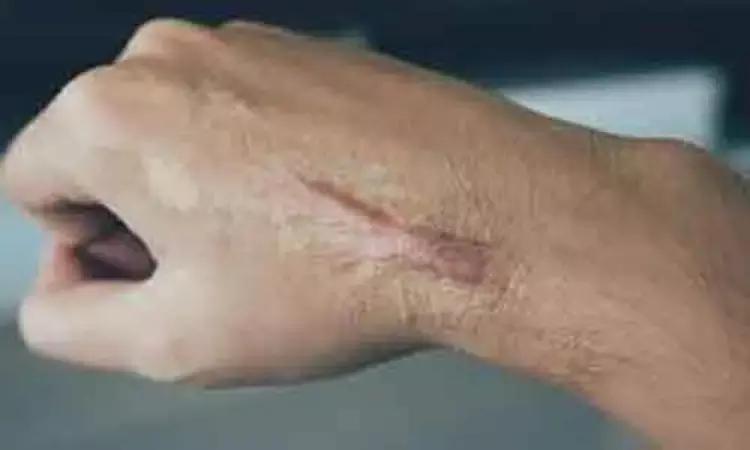- Home
- Medical news & Guidelines
- Anesthesiology
- Cardiology and CTVS
- Critical Care
- Dentistry
- Dermatology
- Diabetes and Endocrinology
- ENT
- Gastroenterology
- Medicine
- Nephrology
- Neurology
- Obstretics-Gynaecology
- Oncology
- Ophthalmology
- Orthopaedics
- Pediatrics-Neonatology
- Psychiatry
- Pulmonology
- Radiology
- Surgery
- Urology
- Laboratory Medicine
- Diet
- Nursing
- Paramedical
- Physiotherapy
- Health news
- Fact Check
- Bone Health Fact Check
- Brain Health Fact Check
- Cancer Related Fact Check
- Child Care Fact Check
- Dental and oral health fact check
- Diabetes and metabolic health fact check
- Diet and Nutrition Fact Check
- Eye and ENT Care Fact Check
- Fitness fact check
- Gut health fact check
- Heart health fact check
- Kidney health fact check
- Medical education fact check
- Men's health fact check
- Respiratory fact check
- Skin and hair care fact check
- Vaccine and Immunization fact check
- Women's health fact check
- AYUSH
- State News
- Andaman and Nicobar Islands
- Andhra Pradesh
- Arunachal Pradesh
- Assam
- Bihar
- Chandigarh
- Chattisgarh
- Dadra and Nagar Haveli
- Daman and Diu
- Delhi
- Goa
- Gujarat
- Haryana
- Himachal Pradesh
- Jammu & Kashmir
- Jharkhand
- Karnataka
- Kerala
- Ladakh
- Lakshadweep
- Madhya Pradesh
- Maharashtra
- Manipur
- Meghalaya
- Mizoram
- Nagaland
- Odisha
- Puducherry
- Punjab
- Rajasthan
- Sikkim
- Tamil Nadu
- Telangana
- Tripura
- Uttar Pradesh
- Uttrakhand
- West Bengal
- Medical Education
- Industry
Study reveals promising new strategies to prevent skin scarring

UK: While scars are common when wounds heal, hypertrophic scarring is a skin condition characterized by deposits of excessive amounts of collagen. This results in a thick and often raised scar. The underlying mechanisms of hypertrophic scar development are poorly understood.
A new study reveals promising new strategies to prevent skin scarring after injuries. The review of strategies for treating hypertrophic scars has been published in the Journal Burns & Trauma.
Skin wound healing is a process that consists of three phases: inflammation, proliferation, and regeneration. Hypertrophic scar formation can occur as a result of an abnormality in these processes. The frequency of such scarring ranges from 40% to 94% following surgery and from 30% to 91% following a burn injury. In poorer countries, the incidence rate is greater reflecting the high rate of burn injuries.
Major risk factors for hypertrophic scar formation include gender, age, genetic predisposition, wound size and depth, anatomical site, and mechanical tension on the wound. Such scarring hinders normal function and obviously results in serious physical, psychological, and aesthetic problems for patients.
It is widely accepted that the time to complete wound healing is the most important factor to predict the development of hypertrophic scars. Only one-third of wounds developed scarring tissue if healing occurred between 14 and 21 days. Some 78% of the sites resulted in serious scarring if the wound healed after 21 days.
The established therapies for preventing serious skin scarring include pressure therapy, which has long been considered the mainstay non-invasive treatment for hypertrophic scarring. It is widely used worldwide and its effectiveness has been established. It's likely more effective suggested that it is more effective if pressure therapy is performed within two months after the initial injury.
Other interventions include silicone, steroids, and laser therapy. While the effectiveness of silicone therapy has not been completely determined, the topical administration of steroids for burn injuries has been generally used and reported to be effective. There is consistent evidence that early laser intervention for the prevention would be beneficial in both the speed of scar reduction and the efficacy of therapeutic response.
Resection (cutting out the tissue) and radiation can often be used in addition to the primary therapies. Surgical approaches do, however, vary with the type of scar. Researchers involved with this paper argue that we need long term results in order to make decisions about using resection or radiation as a medical intervention.
The drug botulinum toxin A (btxA) is widely used for cosmetic purposes, as well as treating headaches and other pain. It is also often used to treat hypertrophic scars. Researchers involved in this paper emphasize that while btxA appears to have some positive effect on scar prevention, researchers still haven't decided on the optimal concentration of the drug to treat scarring. It may depend on the size or severity of the wound. They conclude the drug is promising and worth investigating further.
Future management possibilities for hypertrophic scar therapy include anti-angiogenesis therapy, which inhibits the development of new blood vessels, fat grafting, and stem cell therapy. There are several experimental investigations on the effectiveness of such therapies to reduce abnormal tissue formation.
For more details click on the link: DOI: 10.1093/burnst/tkz003
Hina Zahid Joined Medical Dialogue in 2017 with a passion to work as a Reporter. She coordinates with various national and international journals and association and covers all the stories related to Medical guidelines, Medical Journals, rare medical surgeries as well as all the updates in the medical field. Email: editorial@medicaldialogues.in. Contact no. 011-43720751
Dr Kamal Kant Kohli-MBBS, DTCD- a chest specialist with more than 30 years of practice and a flair for writing clinical articles, Dr Kamal Kant Kohli joined Medical Dialogues as a Chief Editor of Medical News. Besides writing articles, as an editor, he proofreads and verifies all the medical content published on Medical Dialogues including those coming from journals, studies,medical conferences,guidelines etc. Email: drkohli@medicaldialogues.in. Contact no. 011-43720751


